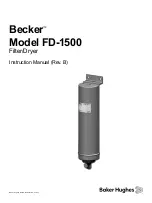
Becker Model FD-1500 Filter/Dryer Instruction Manual
| 1
© 2020 Baker Hughes Company. All rights reserved.
Introduction
The Becker Filter/Dryer is a durable unit designed to
provide dry, clean instrumentation gas by removing parti-
cles, free water, and water vapor from natural gas.
The design of the FD-1500 incorporates a replaceable
“Spin on” cartridge inside a carbon steel housing. Gas
enters the unit from the top and continues around the
narrow passageway between the housing and the car-
tridge increasing the velocity of the gas. The gas enters
the cartridge from the bottom resulting in a complete
change in direction of the flow. This change in direction
in gas flow causes the free water to separate from the
gas. A three-inch space between the bottom of the hous-
ing and the cartridge allows for collection of free water.
The gas then enters the replaceable cartridge. The
replacement cartridge has three main components:
1. A primary filter to remove larger particles.
2. 2 Ibs. of silica gel (desiccant) which can absorb 1 lb.
of water vapor and free water.
3. A secondary fine filter with 110 square inches of media
to strain particles as small as 10 microns.
The FD-1500 provides adequate capacity to flow suffi
-
cient gas for instrumentation. The maximum operating
pressure is 1500 psig (each FD-1500 is hydrostatically
tested to 2250 psig). The flow capacity of the entire unit
is 50 scfm due to the fittings, etc. The capacity of the fine
filter itself at 1500 psig and 10 psid differential pressure
is 212 scfm.
The FD-1500 will provide reliable use if the following
replacement procedure for the cartridge is observed.
Technical Assistance
Should you have any questions, please contact your
local Baker Hughes sales representative.
Useful average life for FD-1500 dryer:
It is a good practice to replace or regenerate the desic-
cant once a year.
Warning:
It is common practice to check the condition of
the dryer by opening the blow down needle valve provid-
ed at the bottom of the FD-1500. This inspection can only
identify the presence of free water flowing with the gas.
If no water is found and the gas appears very dry, it
does not necessarily mean that the desiccant does not
require replacement. The absorption rate of the desic
-
cant depends only on the variables in the formula on the
previous page.
The following table is provided to identify if water fall out
has occurred which may cause freezing problems in the
instruments.
T =
1 lb
7 lb./mmscf x 20 scfh
= 7142 hours = 1 year
The Expected Life Of The Desiccant In The Filter/Dryer Replacement Cartridge Model FD-1500
The life cycle of the desiccant depends on the
following factors:
1. The amount of desiccant in the FD-1500
2. The amount of water in the gas
3. The amount of gas flowing through the FD-1500
The useful life expectancy of the dryer can be
calculated by the formula:
Where:
T = life cycle (hours)
W
d
= desiccant absorption capability (1 lb. for the FD-
1500)
W
q
= amount of water in the gas (Ib./mmscf) for commer-
cial grade natural gas, W
q
= 7 Ib./1mmscf
Q = gas consumption (scfh)
The last factor Q is the most difficult to predict, it can
fluctuate from zero consumption, as in the case of Becker
monitor control valves to a substantially large number, as
in the case of very active control valves. It is good prac-
tice to use Q = 20 scfh. This value represents a steady
state consumption for many instruments that bleed.
T =
W
d
W
q
x Q


























